Photonics and artificial intelligence are enabling the creation of robots with new ways of interacting in business, medicine, imaging and many other applications.
The robot age is upon us. The thought of robots might bring to mind helpful androids like C-3PO in “Star Wars” or Rosie from “The Jetsons” – or it might stir up concern for humankind as advanced robots become more and more indispensable and take over dangerous or boring tasks. Either way, most people don’t realize how ubiquitous robots already are because in their most common forms today, they are less android and more like industrial equipment or tools. Incorporating photonics technology like cameras, sensors, lasers, displays and facial recognition technology, robotics are found everywhere from industrial processing to devices such as pool cleaners and Google’s self-driving car.
Advanced robotics can be found in important commercial applications, such as food processing, packaging and industrial control, often in the form of a programmable, automated “arm.” Consumer robots like the Roomba vacuum cleaner and the Mirra pool cleaner from iRobot Corp. in Bedford, Mass., are not even vaguely humanoid but help with everyday household tasks. The Ava 500 from iRobot is a business-class telepresence robot that can maneuver automatically through hallways and manufacturing floors to enable remote collaboration (Figure 1).
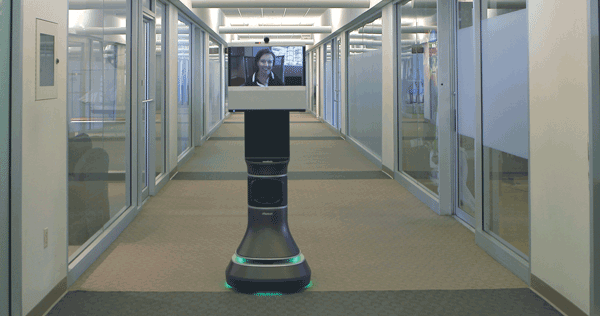
Figure 1. The Ava 500 telepresence robot from iRobot has completed field trials to facilitate collaboration across a distance via intelligent and safe self-navigation to preselected destinations. The user can manually rotate, move up or down, or tilt the robot to image the environment in high-definition video. Photo courtesy of iRobot.
Military robots provide critical search and data-collection functions above ground and underwater, reporting hazards to keep forces safe. Robotic remote-controlled boats and vehicles might serve as educational and entertainment tools in the hobbyist space, or as payload delivery devices, as in the case of unmanned drones. Scientists have developed robots such as the Mars rovers for remote exploration and the da Vinci Surgical System for performing delicate operations (Figure 2).
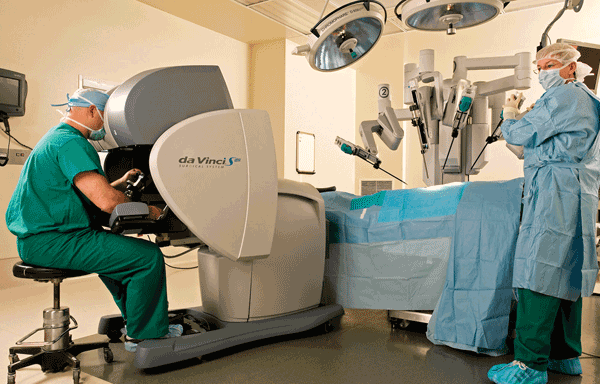
Figure 2. The da Vinci Surgical System was the first robotic surgery system approved by the FDA for general laparoscopic surgery. The physician uses a 3-D high-definition vision system to operate with a 10× magnified view, enabling enhanced precision, dexterity and control. Photo courtesy of da Vinci Surgery.
According to the International Federation of Robotics (IFR), 2013 was the biggest year ever for global sales of industrial robots in the automotive, chemical, materials and food processing industries. The automotive sector uses one-third of all industrial robots, including those to help manufacture cars, as well as robotic technology to help park and control vehicles and avoid collision. The IFR estimates that from 2012 to 2013, the global demand for personal and domestic service robots grew 28 percent to $1.7 billion. Handicap assistance robots are a burgeoning class, as are robotic systems for gaming.
The classic form of robots has made amazing progress, too. With the announcement in January that a hotel in Japan would be staffed by eerily humanlike but entirely robotic personnel, the idea of fleshy humanoid robots from the “Futureworld” or “Westworld” movies just got a step closer (Figure 3). The Henn-na Hotel in Nagasaki Prefecture, which translates as “Strange Hotel,” will have receptionist robots with strong human likenesses that will greet visitors and engage in intelligent conversations. The hotel, scheduled to open in July with 72 rooms, is part of a theme park called Huis Ten Bosch, modeled after a royal palace in the Netherlands. Robots will also provide room service, porter service and housekeeping. Huis Ten Bosch President Hideo Sawada hopes the hotel will be made so efficient through the use of robots and automated features that its success will enable hundreds of hotels like it around the world.
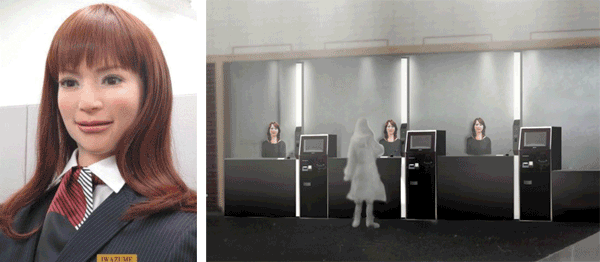
Figure 3. Robots with human-like flesh, robotic vision and conversation skills via artificial intelligence will greet guests in the reception area of the Henn-na Hotel, planned to open this year in Nagasaki, Japan. The kiosk-assisted check-in will use facial recognition technology instead of keys to allow guests access to their rooms. Photo courtesy of seejapan.co.uk.
Less humanoid but more tactile and logic oriented is the Baxter series of robots conceived at Rethink Robotics Inc. in Boston. Baxter is an interactive humanoid robot platform that incorporates 360° sonar sensors, a 1024 × 600 SVGA LCD display “head” and advanced, customized software. Baxter operates beside existing skilled workers to optimize manufacturing, packaging and research processes (Figures 4 and 5). Baxter’s cameras support computer vision applications with 30-fps image capture rate and an effective resolution of 640 × 400 pixels.
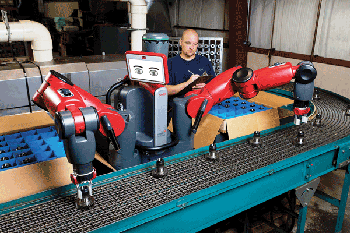
Figure 4. The Baxter series of robots offers imaging technology, advanced sensor design and avoidance response that enable the robots to work safely beside humans in industrial environments. Photo courtesy of Rethink Robotics.
At the official launch of the Australian Centre for Robotic Vision (ACRV) in Brisbane, Australia, in March, researchers from the Queensland University of Technology introduced a Baxter model programmed to use computer vision to play an unbeatable game of Connect Four. They also are programming the robot to pick ripe bell peppers according to color.
“Robotic vision is the key enabling technology that will allow robotics to transform labor-intensive industries, disrupt stagnant markets and see robots become a ubiquitous feature of the modern world,” said Sue Keay, chief operating officer at ACRV.
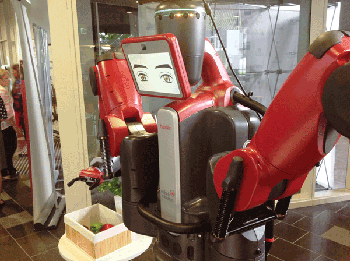
Figure 5. Queensland University of Technology unveiled a version of a Baxter robot that is programmed to identify and pick ripe bell peppers, as well as to play an unbeatable game of Connect Four. Photo courtesy of ACRV.
An IR sensor with a range of 1.5 to 15 in. (4 to 40 cm) is part of Baxter’s accidental-contact avoidance system. The ability to recognize obstacles suddenly in their way and to avoid them is an important feature of robots’ ability to work safely beside humans.
“We’ve tried to ‘rush’ Baxter before and can vouch for his quick reflexes,” said roboticist Peter Corke, professor of science and engineering at Queensland University of Technology and director of ACRV. The center plans to tackle the problem of robot vision by designing new types of low-cost sensors to improve image quality, as well as new algorithms that will accommodate imaging even in poor conditions, such as in the dark or in extreme temperatures, cued by context and sensing of the environment.
In April, Rethink Robotics announced the completion of a Series D round of funding for $40 million, bringing total investment in the company to $113.5 million since its founding in 2008. Said Scott Eckert, president and CEO, “A shortage of manufacturing labor around the world, coupled with manufacturers’ need to respond rapidly to market and product changes, is creating the need for a new kind of robot.”
Flying robots
Another kind of robot is about to become a much bigger part of our world: the unmanned aerial vehicle (UAV) or drone. Drones, like many other robotic technologies, go hand in hand with photonics. Where drones go, cameras, sensors and imaging technology can go. Amazon.com plans to use small drones for package delivery in 30 minutes or less. This plan took another step ahead in March, when the FAA issued permission for Amazon to conduct testing during the daytime within sight of a pilot with a private pilot’s certificate. Also in March, Facebook announced plans to bring Internet connectivity to remote areas using a network of drones and satellites connected via IR lasers in a free-space optics network. Facebook acquired solar-powered drone company Ascenta (UK) Ltd., based in Somerset, UK, and talent from NASA to tackle the project. In April, Google acquired high-altitude drone company Titan Aerospace Corp. of Moriarty, N.M., whose drones have the capability to provide high-quality images in real time that could map the Earth from 65,000 feet high for up to three years while contributing to disaster relief and addressing deforestation. Clearly, these titans of industry recognize the potential of drone technology and are making big investments to make sure that flying robots become a commonplace sight in our world very soon.
That is, if they can get through the bottleneck that is the U.S. Federal Aviation Administration. For the FAA, safely enabling high-volume deployment of private and commercial drones to operate within the regulated environment of the military, commercial and private airspaces is a complex, time-consuming chore. In March, however, the FAA proposed a long-awaited regulatory framework that provides a simple process for drone users applying for exemptions to allow small drones in certain airspaces.
“With this exemption process in play, the market is now open,” says Bryan da Frota, CEO of Prioria Robotics Inc. of Gainesville, Fla., maker of the Maveric UAS, a portable and rapidly deployable unmanned vehicle. In November 2013, Prioria announced several contracts totaling $4.5 million to provide the U.S. Army Rapid Equipping Force with the Maveric Unmanned Aircraft System, a single-person operable and portable aircraft with numerous payload options. Maveric has foldable wings and can be launched from a portable tube. These features enable the system to be carried and hand launched for imaging within 10 miles of a ground station. In some applications, the Maveric can provide resolution of 1 cm per pixel at 300 feet, making it suitable for defense imaging and for surveying in both the mining and oil and gas industries (Figure 6).

Figure 6. The Maveric from Prioria Robotics is a backpack-able, hand-launchable UAV platform measuring just over 2 ft. in wingspan that can carry a wide variety of imaging and sensing payloads for civilian (left) and military (right) applications. Photo courtesy of Prioria Robotics.
Prioria is working on applying image processing to usher in the next generation of robotic capability.
“How does a UAV fly autonomously in an area without GPS?” said da Frota. “How does it avoid obstacles and edit the payload data before transmission so it doesn’t overwhelm the data links with information that isn’t relevant?”
Maveric is equipped to carry a variety of payloads, from simple electro-optical color cameras and IR thermal imaging cameras, to near-IR and short-wave IR systems that allow for agricultural imaging of soil moisture, plant health and imaging through smoke. It also can carry gas sensors and particulate detectors, and eventually the company hopes it will carry lasers. Prioria is installing a hyperspectral imaging payload with an agricultural partner, and in May, the company announced an industrial-grade mapping pod that is the first of its size, quality and class. For these and many other applications, drones and other robotic technology seem poised to become part of our everyday world.